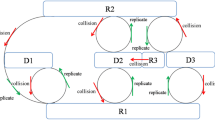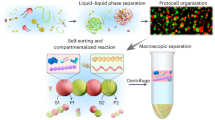Abstract
Recently, we revealed a standard pattern of a macroscopic molecular network for controlling morphogenetic processes such as the development of organs, including blast, mesoderm, heart, and hands during about sevenfold cell divisions and a standard bio-chemical clock like the circadian one (Naitoh in Artif Life Robot 13, 2008; Japan J Ind Appl Math 28(1), 2011; J Phys Conf Ser 344, 2012; Artif Life Robot 17, 2012) A network model derived logically based on experimental observations is described by a nonlinear differential equation for predicting time evolutions of six macroscopic molecular groups: three gene groups and three enzyme groups, which include promoting and suppressing factors. Here, the macroscopic model extended for also describing aging processes shows various types of cycles and reveals the physical condition for determining whether or not living beings such as humans can survive after getting ill. It is stressed that, after becoming ill, living systems with overly fast generation of information molecules such as various genes end in death, whereas relatively fast production of enzymes leads to recovery. This may also explain an essential feature underlying carcinogenic processes.






Similar content being viewed by others
References
Lowe TM, Eddy SR (1997) Nucleic Acids Res 25:955. http://rna.wustl.edu/tRNAdb/)
Nakamura Y, Gojobori T, Ikemura T (2000) Nucl Acids Res 28:292. http://www.kazusa.or.jp/codon/)
DNA Data Bank of Japan. http://www.ddbj.nig.ac.jp/
Ashburner M et al (2000) Gene Ontology: tool for the unification of biology. Nat Genet 25:25–29
Purcell O et al (2010) A comparative analysis of synthetic genetic oscillators. J R Soc Interface 7:1503–1524
Hase T, Tanaka H, Suzuki Y, Nakagawa S, Kitano H (2009) Structure of protein interaction networks and their implications on drug design. PLoS Comput Biol 5(10)
Reilly PR (2004) Is it in your genes?. Cold Spring Harbor Laboratory Press, New York, pp 1–288
Shimizu N (2004) Genome wo kiwameru. Kodansha Scientific, Tokyo, pp 1–144
Naitoh K, Shimiya H (2011) Stochastic determinism. Japan J Ind Appl Math 28–1:3–14
Waddington CH (1957) The strategy of the genes. George Allen & Unwin, London, pp 1–262
Kaufman S (1993) The origin of order. Oxford Press, Oxford, pp 1–717
Eigen M (1992) Steps toward life. Oxford University Press, Oxford, pp 1–173
Prusinkiewiez P, Lindenmayer A (1990) The algorithm of beauty of pants. Springer, Berlin, pp 1–228
Naitoh K (1998) Macroscopic kinetic equation for genetic algorithm. Japan J Ind Appl Math 15–1:87–133
Naitoh K (1998) Introns for accelerating quasi-macroevolutions. JSME Int J C 41–3:398–405
Mullis KB (1990) The unusual origins of the polymerase chain reactions. Sci Am 262:56–65
Naitoh K (2008) Stochastic determinism. Artif Life Robot 13: 10–17. (also in Naitoh K (2008) Onto-biology: inevitability of five bases and twenty amino-acids. Proceedings of 13th international conference on biomedical engineering (ICBME), Singapore. Springer, Berlin)
Naitoh K (2011) Morphogenic economics. Japan J Ind Appl Math 28(1):15–26
Naitoh K (1999) Cyto-fluid dynamic theory. Oil Gas Sci Technol 54:205–210
Naitoh K (2001) Cyto-fluid dynamic theory. Japan J Ind Appl Math 18(1):75–105
Naitoh K (2011) Onto-neurology. In: Proceedings of JSST2011 international conference on modeling and simulation technology, Tokyo, pp 322–327
Naitoh K (2011) Quasi-stability. In: Proceedings of 15th Nordic and Baltic conference on biomedical engineering and biophysics, Denmark
Naitoh K (2012) Spatiotemporal structure: common to subatomic systems, biological processes, and economic cycles. J Phys Conf Ser 344:1–18
Naitoh K (2012) Hyper-gourd theory. Artif Life Robot 17:275–286
Naitoh K (2010) Onto-biology. Artif Life Robot 15:117–127
Naitoh K (2011) Onto-oncology: a mathematical physics underlying the proliferation, differentiation, apoptosis, and homeostasis in normal and abnormal morphogenesis and neural system. Proceedings of 15th Nordic and Baltic conference on biomedical engineering and biophysics, IFMBE proceedings 34, Denmark, pp 29–32
Naitoh K (2009) Onto-biology: clarifying also the standard clock for pre-biotic process, stem-cell, organs, brain, and societies. In: Proceedings of CBEE, Singapore
Naitoh K (2011) The universal bio-circuit: underlying normal and abnormal reaction networks including cancer. In: Proceedings of European IFMBE conference, IFMBE proceedings, Budapest, vol 37, pp 247–250
Takahashi K, Yamanaka S (2006) Induction of pluripotent stem cells from mouse embryonic and adult fibroblast cultures defined factors. Cell 126:663–676
Gilbert SF (2006) Developmental biology, 8th edn. Sinauer Associates, Sunderland, pp 211–251
Nishikawa S (ed) (2008) Ultimate stem cell. Newton 6, pp 12–55
Bear MF, Connors BW, Paradiso MA (2007) Neuroscience. Lippincott Williams & Wiklins Inc., USA, pp 1–855
Hodgkin AL, Huxley AF (1952) A quantitative description of membrane current and its application to conduction and excitation in nerve. J Physiol 117:500–544
Naitoh K (2013) Catastrophic chaos theory: predicting the edge between health and death. In: Proceedings of 18th international symposium on artificial life and robotics
Edelman G (2004) Wider than the sky. Yale University Press, London, pp 1–224
Author information
Authors and Affiliations
Corresponding author
About this article
Cite this article
Naitoh, K., Inoue, H. Catastrophic chaos theory: predicting recovery of health or death. Artif Life Robotics 18, 127–132 (2013). https://doi.org/10.1007/s10015-013-0109-x
Received:
Accepted:
Published:
Issue Date:
DOI: https://doi.org/10.1007/s10015-013-0109-x




